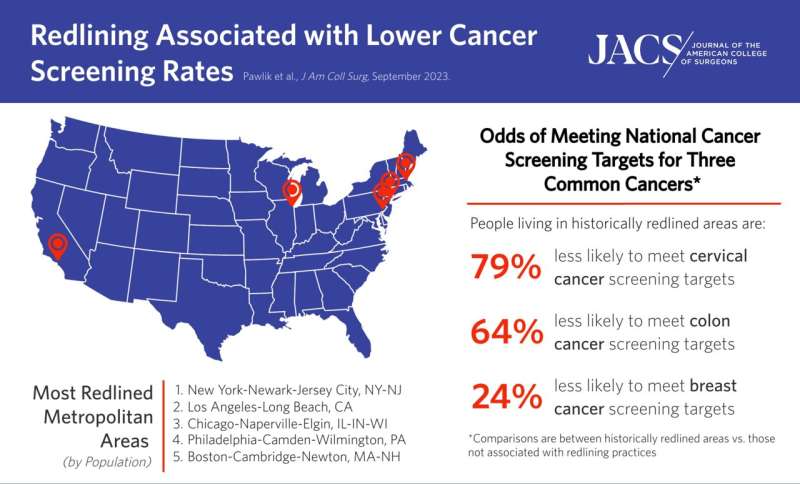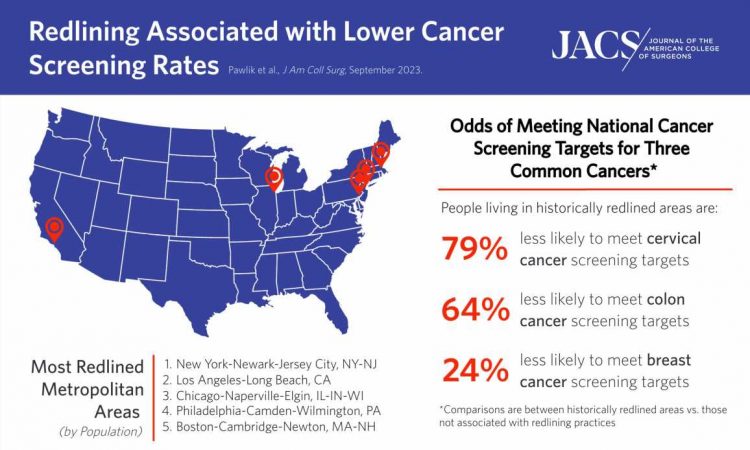
Although redlining was outlawed more than 50 years ago, new research shows that people today who live in historically redlined areas are less likely to be screened for breast, colorectal, and cervical cancer than people who live in areas not associated with redlining practices.
Redlining is a discriminatory practice in which financial institutions refuse to provide loans or insurance to people who live in an area deemed to be a poor financial risk. The practice predominately impacted Black home buyers, contributing to segregation and inequality.
Congress banned the practice under the Fair Housing Act of 1968, but people who live in the areas that were once redlined continue to be negatively affected, as evidenced by low rates of cancer screening, according to a study recently published in the Journal of the American College of Surgeons.
Until this study, the impact of historical redlining on cancer screening, regardless of contemporary social vulnerability, has been largely unexplored.
“Our study shows that the legacy of redlining has a long historical arc that still persists today due to chronic under investment in these areas,” said the study’s lead author Timothy Pawlik, MD, Ph.D., MPH, MTS, MBA, FACS, FRACS (Hon), a surgical oncologist who is the surgeon-in-chief of The Ohio State University Wexner Medical Center. “Redlining serves as a surrogate for systemic racism, especially as it pertains to those who live in areas that lack adequate investment in education, employment, transportation, and healthcare.”
An example of how redlining persists is the case of a national real estate company that was sued for discrimination by fair housing groups for its policy of not offering real estate services to owners selling homes under a minimum price level, Dr. Pawlik said. In 2022, the company, Redfin, agreed to a $4 million settlement and to expand its services for lower-priced houses.
Key study findings
Using national 2020 census-tract level data on cancer screening rates and historical redlining grades, the researchers found that:
- Among 11,831 census-tracts, 3,712 tracts were redlined, with the greatest number of redlined tracts in New York and California, particularly in the New York City and Los Angeles metropolitan areas.
- Redlining was associated with lower odds of hitting screening targets in all three types of cancer: 24% lower odds in breast cancer, 64% lower odds in colorectal, and 79% lower odds in cervical cancer, compared with non-redlined areas. This association persisted even after adjusting for contemporary social vulnerability and access to care.
- A large proportion of the total effect of redlining on cancer screening was attributable to poverty, lack of education, and limited English proficiency.
“I find this study on the impact of historic redlining practices on current cancer screening rates to be incredibly important and sobering. The findings clearly demonstrate that the legacy of redlining continues to contribute to significant disparities in breast, colorectal, and cervical cancer screening, highlighting the urgent need for targeted interventions and policy reforms to address underlying structural racism and improve health equity in our historically marginalized communities,” said David Tom Cooke, MD, FACS, professor and chief of the Division of General Thoracic Surgery at UC Davis Health, and president of the Thoracic Surgery Directors Association.
Dr. Cooke, who was not involved with the study, added, “This study underscores the responsibility of healthcare systems, including academic and non-academic medical centers, to proactively tackle social determinants of health, such as redlining, to achieve equitable access to cancer screening and ultimately save lives.”
How to alleviate the impact of redlining on cancer screening rates
By demonstrating the long-term implications of discriminatory practices, the study results can help shape healthcare and social policy reform to reduce health inequities, Dr. Pawlik said.
Those efforts start with specific, actionable initiatives, Dr. Pawlik said. To determine how to improve cancer screening rates in specific areas may require resident questionnaires to determine the potential barriers, he said. For example, if transportation was a barrier, travel vouchers could be provided; or if English proficiency was a barrier, an interpreter could be provided.
Among the approaches that could help improve cancer screening rates in historically redlined areas include:
- Government policies that target the areas with social services aimed at poverty alleviation, affordable housing, and education.
- Initiatives to improve access to preventive cancer care may mitigate cancer screening disparities. One example is the Mobile Mammography Van by the Navajo Breast and Cervical Cancer Prevention Program.
- Alternative methods to make it easier for affected people to get screened. For example, since colonoscopies pose significant barriers, such as bowel prep and devoting most of the day for the exam, tests to detect DNA mutations and blood in the stool may be a more workable approach, Dr. Pawlik said.
“I think the fact that the cancer screening is so disparate in these communities is a real wake up call to all of us,” Dr. Pawlik said.
More information:
Zorays Moazzam et al, Association of Historical Redlining and Present-Day Social Vulnerability with Cancer Screening, Journal of the American College of Surgeons (2023). DOI: 10.1097/XCS.0000000000000779
Journal information:
Journal of the American College of Surgeons
Source: Read Full Article
